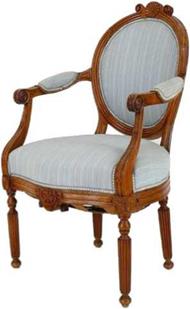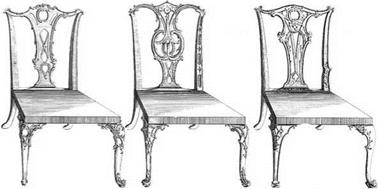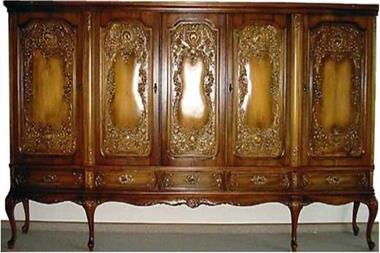In France, under the influence of archaeological discoveries in Pompeii and Herculaneum, a significant turn occurred towards antique forms. Furniture was deprived of Baroque features, structures were significantly simplified, replacing curved lines with straight elements. Chairs, though almost unchanged, compared to the previous era, were characterised mostly by grooved legs. The connection of cases and legs was strongly emphasised by the presence of a cuboid cube usually
|
Fig. 1.35 Drawings of chairs by Thomas Chippendale (1753) (Thomas Chippendale, The Gentleman and Cabinet Maker’s Director, London 1754. The Chippendale Society) |
|
Fig. 1.36 Chest of drawers made by Thomas Chippendale, around 1760 |
decorated with a sculpted rosette. The backrests, usually concave, were in the shape of a medallion or openwork lyres. The skeletons were painted with light-coloured paints, gilded or finished with waxes. The seats were finished with gobelin fabrics (Fig. 1.37).
Chests of drawers, desks, escritoires had smooth surfaces, cornices, side frames and straight legs. At that time, the following appeared: buffet—commodes and shelf-commodes, chiffoniers—small cabinets with elongated proportions and fitted at the front with drawers, glazed bookcase cabinets, the desk in the form of an ordinary table. Furniture for writing was produced with special care for their
Fig. 1.37 Armchair in the style of Louis XVI (Galeria Glorious Antiques Sp. z o. o.)
 appropriate dimensions ensuring comfort of office work. Also a comfortable, large, extendable dining table appeared, known from the Renaissance period.
appropriate dimensions ensuring comfort of office work. Also a comfortable, large, extendable dining table appeared, known from the Renaissance period.
In England, Robert Adam, George Hepplewhite and Thomas Sheraton had a significant impact on the evolution of furniture design. In particular, the last two are considered the creators of native directions of the English furniture industry. Hepplewhite’s chairs have straight legs, tapered towards the bottom, with a round or square section, while the backrests have oval forms, shield-shaped, heart-shaped and in the shape of a camel’s hump, etc. (Fig. 1.38).
Sheraton developed new backrest shapes in the form of a rectangle with vertical lines (Fig. 1.39). The most commonly used motif, however, was three overlapping, sharply finished ovals or three palm leaves set into the oval. In addition, he also designed sofas and case furniture.
Among the case furniture, two – and three-chambered designs were produced for storing clothing and/or books. A number of chests of drawers could also be encountered: with three or more drawers at the bottom, with two door wings in the central part, with drawers placed on the sides, as well as many other forms in between designed on this basis (Fig. 1.40).
Among tables, round, oval and rectangular structures prevailed, with the function of folding or sliding one under the other. There were also dresser tables, toiletry tables, tables for writing in the form of an escritoire with a variety of compartments (Fig. 1.41).
During the period of English classicism, wooden elements of furniture were finished with a wax varnish, leaving its natural colour and texture of the base. The
 |
 |
most commonly used wood was mahogany, which was finished by marquetry with light-coloured, speckled and veined veneers made of lemon or satin wood.





